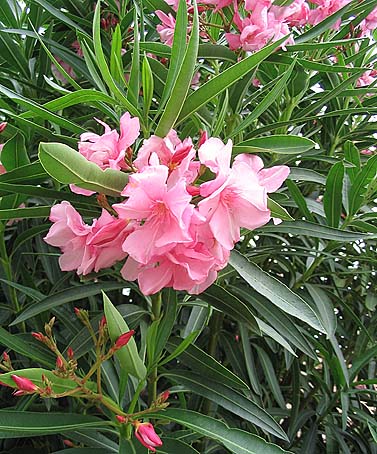
Oleander is an evergreen shrub or small tree and a member of the dogbane family, Apocynaceae, that also includes blue star (Amsonia), periwinkle (Vinca), and milkweed (Ascelpius). Its native range is uncertain because it has been so widely cultivated over the centuries but it is generally associated with the Mediterranean Basin. Oleander is wide spread in southern Italy and grows in modern Pompeii. Oleander pollen and leaf impressions have been found in the ashes and suggest that the shrub was present in ancient times. The ancient Roman naturalist, Pliny the Elder (d 79 A.D.) tells us in his work, Natural History, that oleander came from Greece and notes that “the leaves of this plant are poisonous to quadrupeds; while for man, if taken in wine with rue, they are an effectual preservative against the venom of serpents.” He also mentions that in Pontus honey made from oleander blossoms was poisonous but reports its medicinal uses and refers to it as soporific, failing to recognize that oleander is toxic to humans. Pliny also notes that the flowers were used in making chaplets. The frequent depiction of the blooming oleander in ancient Pompeian wall paintings suggests its popularity as an ornamental. Photo Credit Wikipedia
Description: Plants grow 6.5-20′ tall and have cane-like stems with shiny green twigs and paired whorls of 3-4, leathery lanceolate leaves 4-10″ long. The leaves are dark green above and paler with a prominent midrib below. From late spring to late summer, terminal clusters of 4-5 flowers appear. Each flower is 5-lobed, 2.5″ wide, and may be yellowish, red, white, pink, orange or purple. Some cultivars are fragrant and may have double flowers.
Size: 6.5-20′ H x 6-10′ W
Light: Full sun
Soil: Average, medium moist, well-drained but tolerates drought
Hardiness: Zones 8-10